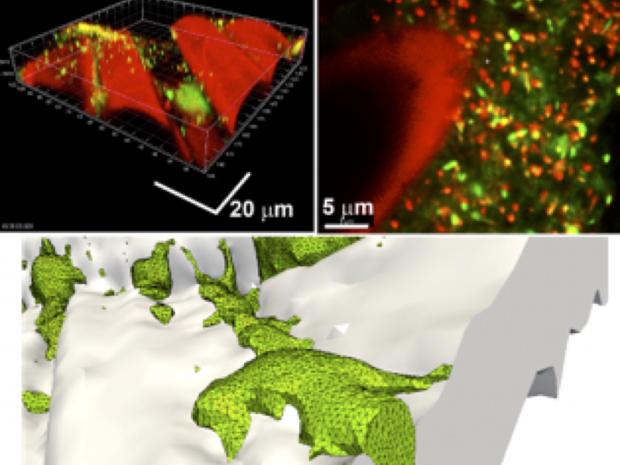Mechanical properties of biofilms as a mechanism for survival on surfaces

Mechanical and Aerospace Engineering Department Seminar Series
Mechanical properties of biofilms as a mechanism for survival on surfaces
Paul Stoodley
Ohio State University
College of Medicine
Bacterial biofilms are microscopic assemblages of bacterial cells usually attached to a surface and held together by a self-produced extracellular polymeric slime (EPS) matrix. Biofilms are ubiquitous in nature and are highly problematic in industry and medicine where they cause corrosion, fouling, contamination and chronic medical and dental infections. The EPS matrix is chemically complex and is composed of polysaccharides, lipids, proteins and DNA and protects the bacteria within from antibiotics chemical challenges and host immunity. Mass transfer through the EPS is dominated by diffusion which, allows the development of gradients in nutrients, waste products and cell signals. The highly localized and heterogeneous chemical microenvironment caused by the metabolic activity of the biofilm can be corrosive and cytotoxic and facilitates the development of a dormant persister population. Additionally, the bulk mechanical properties of biofilms also appear to play a role in survival by allowing the biofilm to respond to imposed mechanical loads over very short (ms) and very long (days to weeks) time scales. Creep and relaxation tests show that generally biofilms behave as viscoelastic liquids however, they also undergo strain hardening and recent observations of high-velocity impacts with water droplets suggest they rapidly undergo shear thinning, allowing them to flow over surfaces with velocities of meters per second. In this seminar I will give an overview of biofilm development using medical case studies to illustrate the consequences of biofilm formation in infection and the difficulties in prevention and treatment. Then the processes of biofilm formation and behavior in response to mechanical forces will be presented to open up discussion relating structure and mechanical properties to function
Biosketch
Dr. Stoodley has over 25 years experience in biofilm research. Dr. Stoodley completed his Ph.D. in Biological Sciences at Exeter University on biofilm–hydrodynamic interactions before returning to the CBE for postdoctoral training on the role cell signaling and hydrodynamics on biofilm formation and mechanical properties. This research led to the creation of the Biofilm Mechanics research group of which he was the group leader. Between 2003 and 2008 Dr. Stoodley held the posts of Associate Professor of Immunology and Microbiology with Drexel College of Medicine before joining Ohio State University. Dr. Stoodley serves as a consultant for Philips Oral Healthcare POH and Biocomposites. Dr. Stoodley has published over 130 articles including reviews, research papers and book chapters in various clinical and academic journals; he has given over one hundred seminars where he has presented his to a wide variety of academic, industrial and healthcare international audiences. Dr. Stoodley has been funded from a variety of US and UK government agencies as well as from industrial partners.

